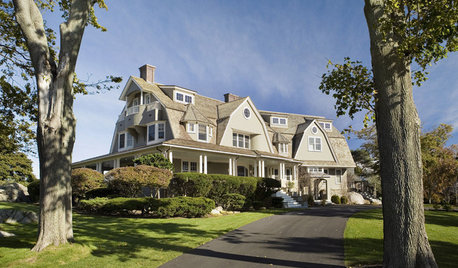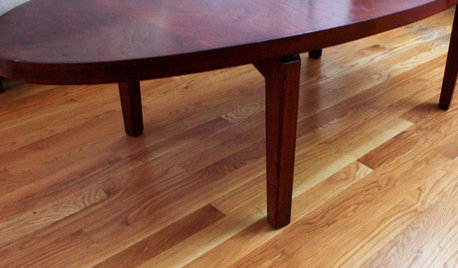Tea types? Quickly tall or slowly wide?
sherryocala
13 years ago
Featured Answer
Sort by:Oldest
Comments (25)
organic_tosca
13 years agolast modified: 9 years agocweathersby
13 years agolast modified: 9 years agoRelated Discussions
Slowly I organized ... inch by inch, step by step
Comments (48)Hooray for empty cabinets! I've got some empty space now as well. So strange and wonderful. Ended up with commercially made metal wall shelves in the garage and the spacing didn't work out for a rack over the freezer but at least there are a couple of bins on top rather than things that could fall behind. If something can fall behind it will and if you make a stack it will fall over so I avoid them at all cost. I am not happy that the space between dryer and freezer is unassigned, someday inspiration will strike. My garage is done. Had a great time making hangers from scrap wood for that big stuff that won't fit on shelving. Best was solving 2 issues at once. Needed a way to store garden tools and had a wood box without a job. It was originally for computer boards, about 8" square in cross section and about 30" long. I turned it on its side and cut slots through what used to be the sides to hang long handled tools. A slot cut through one side now top holds the loppers upside down and I used scrap hardboard to make dividers that conveniently slid into the board slots. That helps support the tools and made some little spaces for my gardening shoes, pruners and gloves. Used a couple of shelf supports without a job to hang it on the wall....See MoreWhat's the type of my Succulent? Grown too tall
Comments (9)It is positively a kalanchoe. Maybe longiflora. I wouldn't worry about etoliation, kalanchoes don't form the tight rosettes that echeverias do. Kalanchoes prefer bright, indirect light and more hummus rich soil. I would repot to one size larger, use 2 parts potting mix and 1 part perlite or pumice. Repotting multi stemmed plants only seems scary, once you have her out of the dirt it's easy. Utilize YouTube, there are some fantastic gardeners that will walk you through the process step by step. And I would keep the babies in the pot. Kalanchoes produce babies on the end of their leaves that readily grow just about anywhere. These guys are easier to remove than the rooted ones in the pot. I say it looks like you're taking great care of her and you seem very aware of her changes, so just keep up the good work. Check out the kalanchoe section on worldofsucculents.com It's my favorite resource and you're sure to learn something new!...See MoreSlowly Coming Back from the Brink
Comments (28)Lisa, I planted Echium gentianoides 'Tajinaste' which I swear is made out of sandpaper, because that's how the leaves feel. It is doing fine, but its neighbor, Penstemon 'Blue Springs' seems to be biting the dust in the heat. I'm not sure whether it's even still alive. My two Salvia 'Henry Duelburg' are sitting on the bench in their small pots because I was afraid they would not fare well in the ground this time of the year. It's a good thing that yours had cooler weather in which to get acclimated. vesfl, I'm touched by your very kind comment. Thanks so much. It's really just that we think of our outside critters as an extension of our family, and of course the children must be fed and given something to drink. bart, I second every one of your thoughts. I've been out only briefly in the near-dark in the past few days, and that's actually the only time the garden looked good. I try to even avoid looking out the window during the day because the view is so much less than edifying. Here is a picture my husband took of the ground squirrels. How could anyone resist?...See MoreThin tall doorway - need opinion on type
Comments (3)@WoW Washington my concern is that the small entry/exit opening takes away from the feel of a nice doorway when people move in/out since many people can't move out straight without a slight sideways adjustment when moving through a door clear opening that is only 23". I didn't realize that sliders can be quickly removed though an 8' slider may still be too heavy to be removed easily....See Moresherryocala
13 years agolast modified: 9 years agoingrid_vc so. CA zone 9
13 years agolast modified: 9 years agoorganic_tosca
13 years agolast modified: 9 years agosherryocala
13 years agolast modified: 9 years agomelissa_thefarm
13 years agolast modified: 9 years agoUser
13 years agolast modified: 9 years agocarolinamary
13 years agolast modified: 9 years agosherryocala
13 years agolast modified: 9 years agogardennatlanta
13 years agolast modified: 9 years agoorganic_tosca
13 years agolast modified: 9 years agosherryocala
13 years agolast modified: 9 years agogardennatlanta
13 years agolast modified: 9 years agoharborrose_pnw
13 years agolast modified: 9 years agosherryocala
13 years agolast modified: 9 years agogardennatlanta
13 years agolast modified: 9 years agobuford
13 years agolast modified: 9 years agoingrid_vc so. CA zone 9
13 years agolast modified: 9 years agocarolinamary
13 years agolast modified: 9 years agosherryocala
13 years agolast modified: 9 years agojerome
13 years agolast modified: 9 years agosherryocala
13 years agolast modified: 9 years agojerome
13 years agolast modified: 9 years ago
Related Stories

HOUZZ TOURSDesign Lessons From a 10-Foot-Wide Row House
How to make a very narrow home open, bright and comfortable? Go vertical, focus on storage, work your materials and embrace modern design
Full Story
GARDENING GUIDESGreat Design Plant: New Zealand Tea Tree
Balance pretty polish and ruggedness in a temperate garden with this low-maintenance and drought-tolerant flowering shrub
Full Story
GARDENING GUIDESGreat Design Tree: Australian Tea Tree
A living sculpture with an unmistakable appearance, this coastal native creates an intriguing landscape scene
Full Story
HOUSEKEEPINGThe Quick and Easy Way to Clean a Microwave
All you need is water and a couple of other natural ingredients to get your appliance sparkling and smelling fresh again
Full Story
GARDENING FOR BUTTERFLIESA Quick-Start Guide to Bird-Watching for Fun and Learning
Set out some seed and grab your field guide. Bird-watching is an easy, entertaining and educational activity for the whole family
Full Story
CONTAINER GARDENS3 Steps to Creating Quick, Easy and Colorful Succulent Containers
Take a bright container, add a colorful succulent or two and have a professional, summery design in minutes
Full Story
DECORATING GUIDESQuick Fix: Find Wall Studs Without an Expensive Stud Finder
See how to find hidden wall studs with this ridiculously easy trick
Full Story
LIFEA Quick Downsizing Quiz for the Undecided
On the fence about downsizing? We help you decide whether that fencing should encircle a mansion or a mini trailer
Full Story
HOUSEKEEPINGFurniture Clinic: Quick DIY Glides for Sofa, Chair or Table
Smooth things over between your furniture and floor with easy glides cut from leather scraps
Full Story
MATERIALSFabric Focus: Decorate With Grain Sacks for Quick Farmhouse Style
Vintage and reproduction grain sack material creates thick, durable upholstery for sofas, chairs, pillows and more
Full Story







harborrose_pnw